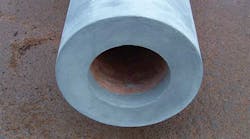It’s hard to calculate the full effect of the melting process on the copper tuyeres that are necessary to supply fuel and additives to cupola furnaces. The heat, just to take the obvious hazard, is intense, but so too is the atmospheric pressure. Slag and molten metal bring another dimension of damage to tuyere performance.
Morrison Engineering, Middlesbrough, England, developed a ceramic coating technique to protect tuyeres from corrosion abrasion and molten metal damage in cupolas, as well as blast furnace ironmaking.
The primary raw material for the ceramic coating is high-strength silicon carbide, which imparts very high strength in combination with a greater resistance to thermal shock than conventional refractories.
In addition, silicon carbide provides high thermal conductivity and exceptional abrasion resistance. “The ceramic is so tough and hard, only diamond tip grinding can machine it,” the developer noted.
The physical characteristics of any tuyere with the applied ceramic would be similar to an original design condition; the internal cooling properties and water consumption are not changed.
The ceramic is attached to the tuyere using a unique dual bonding system developed by Morrison Engineering: Beneath the ceramic, the tuyere has a normal copper nose and body, so that when the ceramic has reached the end of its normal service life (or is damaged prematurely), the tuyere continues to operate as normal.
A typical ceramic application is 15 mm thick, covering the front of the tuyere nose and 250 mm of the tuyere body. Variations and prototypes can be manufactured to suit individual furnace and melt shop requirements.









